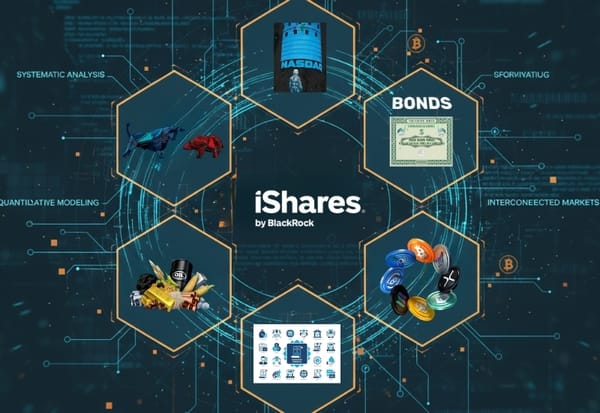Web3 Revolution: How Blockchain Could Save Social Security's Future
Social Security faces a $25T crisis by 2033. While politicians debate old solutions, Web3 offers revolutionary transparency, smart contract automation & market returns without privatization fears. Discover how blockchain could save America's retirement future.

The Social Security Trust Fund faces an unprecedented crisis, with the latest trustees' report projecting depletion by 2033—just eight years away. As the program heads toward automatic benefit cuts of 23%, innovative solutions are desperately needed to address this $25 trillion shortfall over the next 75 years. While politicians debate traditional fixes, emerging Web3 technologies offer a revolutionary paradigm that could modernize Social Security while addressing its core challenges: funding shortfalls, outdated logistics, and concerns about privatization.
The Trust Fund Crisis: Beyond Traditional Solutions
Social Security's primary trust fund will be depleted within the next decade, forcing benefit cuts of over 20% unless Congress acts. The program's demographic challenges are staggering: in 1960, there were more than five workers paying Social Security taxes per beneficiary, but that ratio has dropped to just three-to-one. Traditional solutions focus on raising taxes or cutting benefits, but Web3 technology offers a third path that could revolutionize how we approach social insurance entirely.
Social Security's shortfall equals $192,000 for every household in America—$19,000 more than just one year ago, representing a four-fold increase since 2010. This exponential growth in obligations demands exponential innovation in solutions.
Web3's Revolutionary Approach to Trust Fund Management
Web3 technology, built on blockchain foundations, offers unprecedented transparency and efficiency improvements that could directly address Social Security's core challenges. Blockchain brings accountability and transparency to governmental processes while enabling transparent and secure financial transactions without relying on centralized authorities.
The current Social Security system suffers from opacity—workers can't see real-time data about their contributions, fund performance, or administrative costs. Web3 enables agencies to provide more transparent reporting, thus improving accountability and facilitating data extraction while reducing the risk of changes to recorded transaction details. Imagine a blockchain-based Social Security system where every contribution, every administrative expense, and every investment decision is recorded on an immutable ledger, viewable by any participant.
Smart Contracts for Automated Administration
Smart contracts are self-executing contracts with predefined rules that automate various financial processes, eliminating the need for intermediaries. Applied to Social Security, smart contracts could automate benefit calculations, cost-of-living adjustments, and eligibility determinations, dramatically reducing administrative costs while eliminating human error and processing delays.
Web3's fundamental technology enables supplier data validation by trusted validators and provides an immutable audit trail, while smart contracts have pre-set instructions to regulate transactions automatically. This same framework could revolutionize Social Security administration, ensuring benefits are calculated correctly and distributed efficiently without the bureaucratic overhead that currently consumes administrative resources.
Solving Outdated Logistics Through Decentralized Infrastructure
Social Security's current infrastructure relies on antiquated systems and centralized databases that create inefficiencies and single points of failure. Web3 integrated systems offer distributed ledger technology that ensures seamless tracking and monitoring of end-to-end operations while providing detailed product history and improved transparency.
Real-Time Identity Verification and Record Management
Unlike Web2 systems that rely on companies to store and verify identity through third-party services, Web3 utilizes blockchain technology to create decentralized identity management systems where individuals hold the keys to their own data. This could eliminate Social Security number fraud and ensure that contributions are properly credited to the correct individuals in real-time.
Web3 enables seamless storage and accessibility of all relevant information and documents, improving trustworthiness and coordination among all participants while eliminating paperwork and risk. Workers could have instant, secure access to their complete earnings history, benefit projections, and account status without relying on annual statements or bureaucratic inquiries.
Privatization Without the Fears: A Decentralized Approach
Politicians often frame privatization as an all-or-nothing proposition, but Web3 offers a nuanced middle path. Many oppose privatization due to concerns about market volatility and the loss of guaranteed income, with critics arguing it could "cause chaos" due to political implementation challenges.
However, Web3-enabled systems could address these concerns through:
Transparent, Diversified Investment Strategies
Rather than individual account management, a Web3-based system could implement transparent, algorithmic investment strategies managed by smart contracts. DeFi platforms enable users to engage in peer-to-peer lending and access decentralized finance services that democratize finance while enhancing security and transparency. These systems could automatically diversify investments across multiple asset classes while maintaining the stability and predictability that Social Security beneficiaries require.
Risk Mitigation Through Decentralized Governance
Web3 technologies include decentralized autonomous organizations (DAOs) and blockchain governance models that combat corruption and achieve transparency in the public sector. A Web3 Social Security system could implement decentralized governance where stakeholders vote on investment strategies and policy changes through transparent, tamper-proof blockchain voting systems.
The S&P 500 Alternative: A Historical Perspective
To understand the potential impact, consider how Social Security benefits would compare if contributions had been invested in the S&P 500. A median income earner working since 1975 would retire at age 67 with over $3.7 million in their account, generating $15,523 per month in interest alone, compared to the average Social Security benefit of just $1,883 per month.
However, critics argue that such comparisons are "apples-to-oranges" because they ignore transition costs, risk factors, and the insurance components of Social Security that provide disability and survivor benefits. A Web3 solution could address these concerns by maintaining insurance features while optimizing investment returns through transparent, algorithmic management.
Risk-Adjusted Returns in a Web3 Framework
BlackRock CEO Larry Fink noted that if President Bush's 2005 privatization efforts had succeeded, Americans would have seen their retirement money increase fourfold based on S&P 500 returns. A Web3 system could capture similar gains while mitigating risks through:
- Automated dollar-cost averaging to reduce market timing risks
- Smart contract-enforced diversification requirements
- Transparent fee structures eliminating hidden costs
- Real-time risk monitoring and adjustment protocols
Implementation Framework: XRP and Ripple Integration
XRP and Ripple's technology stack offers particular advantages for Social Security modernization:
Cross-Border Payment Efficiency
Ripple's payment infrastructure could facilitate instant, low-cost benefit distributions to retirees living abroad, eliminating the delays and fees associated with traditional international transfers.
Central Bank Digital Currency (CBDC) Integration
As the Federal Reserve explores digital dollar implementations, XRP's technology could serve as the backbone for a digital Social Security system, enabling programmable benefits with built-in compliance features.
Partnership Opportunities
Ripple's established relationships with financial institutions position it to facilitate the transition from traditional Social Security administration to a Web3-enabled system, providing the enterprise-grade infrastructure necessary for a program serving 70+ million beneficiaries.
Addressing Political Concerns: Transparency Over Control
Politicians fear that privatization exposes people to precisely the risk that Social Security was designed to guard against, with concerns about "forces beyond their control". Web3 addresses these concerns by providing unprecedented transparency and democratic governance rather than transferring control to Wall Street.
Unlike traditional privatization proposals that would subject individual accounts to market volatility, a Web3 Social Security system could implement risk-pooling mechanisms while maintaining individual ownership and transparency. Web3 banking significantly enhances transparency, efficiency, and security compared to traditional financial systems through blockchain's inherent security features and public ledger recording.
Market and Regulatory Implications
The transition to a Web3-based Social Security system would create massive demand for blockchain infrastructure and digital assets, potentially driving significant adoption of platforms like XRP. Government agencies should facilitate research into open-source, permissionless blockchain systems to promote national security and support private-sector solutions.
This shift would also establish the United States as a global leader in government blockchain implementation, demonstrating how democratic institutions can leverage decentralized technologies while maintaining accountability and public oversight.
A Third Way Forward
Web3 technology offers a revolutionary solution to Social Security's crisis that transcends the traditional privatization versus government control debate. By leveraging blockchain transparency, smart contract automation, and decentralized governance, we can create a system that provides better returns than the current structure while maintaining the security and predictability that Americans expect.
The choice isn't between risky privatization and an unsustainable status quo. Web3 offers a third path: transparent, efficient, and democratically governed social insurance that harnesses market returns while maintaining social solidarity. As Social Security faces its greatest challenge in 90 years, emerging technologies provide the tools to not just save the system, but to transform it into a model for the 21st century.
DISCLAIMER: This newsletter is for informational purposes only and does not constitute investment advice or a recommendation to buy, sell, or hold any securities. Investments in cryptocurrencies or other financial assets carry significant risks, including the potential for total loss, extreme volatility, and regulatory uncertainty. Past performance is not indicative of future results. Always consult a qualified financial professional and conduct thorough research before making any investment decisions.
Sources and Additional Reading
- Social Security Trustees Report 2025 - Official projections and financial analysis
- Center on Budget and Policy Priorities - Social Security Analysis - Social Security policy analysis
- Committee for a Responsible Federal Budget - 2025 Analysis - Fiscal impact assessments
- Blockchain Council - Web3 Guide - Web3 technology frameworks
- Brookings Institution - Privatization Analysis - Social Security privatization analysis
- Heritage Foundation - Rate of Return Study - Rate of return calculations
- Cato Institute - Market Analysis - Market-based Social Security reform proposals
- Center for American Progress - Privatization Risks - Privatization risk analysis
- EPIC for America - 2025 Trustees Report - Financial deterioration analysis
- Social Security Privatization Calculator - S&P 500 vs Social Security comparison tool
- ScienceDirect - Blockchain Government Transparency - Academic research on blockchain transparency
- Route Fifty - Government Web3 Applications - Municipal blockchain case studies
- TechHQ - Web3 Financial Implications - Financial sector Web3 analysis
- Solulab - DeFi in Web3 - Decentralized finance framework analysis
- LeewayHertz - Web3 Supply Chain - Supply chain blockchain applications
- Maticz - Web3 Logistics - Logistics transformation analysis
- Antier Solutions - Blockchain Identity - Digital identity management
- XEROF - Web3 Banking Guide - Web3 financial services overview
- a16z Crypto - Government Web3 Policy - Policy recommendations for Web3 adoption
- CNBC - Social Security Privatization Debate - Current privatization discussions
This analysis represents theoretical applications of Web3 technology to social insurance challenges and should not be construed as specific policy recommendations.



